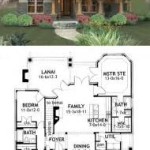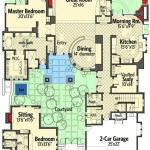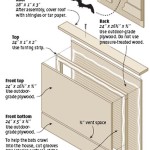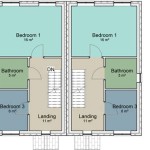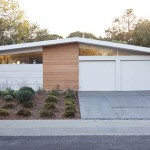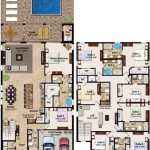Open Floor Plan Houses: A Guide To Spacious and Modern Living
Open floor plan houses have become increasingly popular in recent decades, representing a significant shift in residential design preferences. Characterized by the minimization or elimination of walls separating traditionally distinct living spaces, such as the living room, dining room, and kitchen, open floor plans aim to create a more spacious, fluid, and interconnected environment. This design concept prioritizes communal living and offers a variety of benefits, while also presenting unique challenges that require careful consideration.
The core principle of an open floor plan is to maximize the available square footage and create a sense of openness. Instead of compartmentalized rooms, the design focuses on a single, continuous space that facilitates interaction and movement. This approach can significantly alter the way residents experience their home, promoting a more social and interactive lifestyle.
This guide explores the advantages and disadvantages of open floor plans, providing insights into design considerations, practical applications, and the overall suitability of this modern architectural style for different lifestyles and needs.
Increased Natural Light and Enhanced Spaciousness
One of the primary benefits of an open floor plan is the increased natural light it provides. With fewer walls obstructing the passage of sunlight, natural light can permeate deeper into the living space, creating a brighter and more inviting atmosphere. This increased illumination reduces the need for artificial lighting during the day, contributing to energy savings and a more sustainable living environment.
The absence of dividing walls also contributes to a heightened sense of spaciousness. An open floor plan visually expands the living area, making even smaller homes feel larger and more airy. This is particularly beneficial in urban environments where space may be limited.
Furthermore, the open design allows for better ventilation and airflow throughout the living area. Natural breezes can circulate more freely, reducing humidity and improving overall air quality. This can lead to a more comfortable and healthier living environment.
From a design perspective, the abundance of natural light and spaciousness provides greater flexibility in furniture arrangement and interior décor. Open floor plans accommodate a wider range of layouts and allow for more creative expression in interior design.
Facilitated Social Interaction and Family Connectivity
Open floor plans are inherently conducive to social interaction and family connectivity. By eliminating barriers between the kitchen, living room, and dining area, the design encourages communication and engagement among family members and guests. Individuals preparing meals in the kitchen can easily participate in conversations taking place in the living room, fostering a sense of togetherness.
This design is particularly advantageous for families with young children. Parents can supervise their children playing in the living room while simultaneously preparing meals in the kitchen, ensuring their safety and well-being. The open layout also allows for easier monitoring of children’s activities and facilitates spontaneous interaction.
Open floor plans are also ideal for entertaining guests. The seamless transition between different living areas allows for easy flow of traffic and facilitates social interaction. Guests can mingle freely between the kitchen, living room, and dining area, creating a more relaxed and convivial atmosphere.
In essence, open floor plans promote a more social and interactive lifestyle, strengthening family bonds and enhancing the overall sense of community within the home.
Design and Functionality Considerations
While open floor plans offer numerous benefits, careful consideration must be given to design and functionality to ensure a comfortable and practical living environment. One of the key challenges is defining distinct zones within the open space without resorting to physical barriers. This can be achieved through a variety of design techniques, including the use of furniture arrangement, area rugs, changes in flooring material, and variations in ceiling height.
Furniture can be strategically placed to delineate different living areas. For example, a large sectional sofa can define the boundaries of the living room, while a dining table and chairs can create a distinct dining area. Area rugs can further emphasize these zones, adding visual interest and defining the boundaries of specific spaces.
Changes in flooring material can also be used to differentiate between different areas. For instance, hardwood flooring in the living room can transition to tile flooring in the kitchen, creating a subtle visual distinction. Variations in ceiling height can also be employed to define different zones, with higher ceilings in the living room and lower ceilings in the kitchen to create a sense of intimacy.
Another important consideration is noise control. With fewer walls to absorb sound, noise can travel more freely throughout the open space. This can be particularly problematic in households with multiple occupants or those who enjoy watching television or listening to music at high volumes. To mitigate noise issues, it is important to incorporate sound-absorbing materials into the design, such as upholstered furniture, thick curtains, and soft flooring.
Proper ventilation and temperature control are also crucial in open floor plans. Without walls to regulate airflow, it can be difficult to maintain a consistent temperature throughout the living space. This can be addressed by installing efficient HVAC systems and utilizing ceiling fans to circulate air. Strategically placed windows and doors can also promote natural ventilation and help to regulate temperature.
Storage is another important consideration in open floor plans. With fewer walls to accommodate built-in storage, it is important to incorporate creative storage solutions into the design. This can include using furniture with built-in storage, such as ottomans with hidden compartments or coffee tables with drawers. Open shelving can also be used to create visually appealing storage spaces, while also displaying decorative items and personal belongings.
Maintaining cleanliness and organization is essential in open floor plans. Because there are fewer walls to conceal clutter, it is important to develop a consistent cleaning routine and to keep surfaces clear of unnecessary items. This will help to maintain a sense of spaciousness and create a more inviting living environment.
Ultimately, the success of an open floor plan depends on careful planning and attention to detail. By considering these design and functionality considerations, it is possible to create a comfortable, practical, and visually appealing living space that reflects the unique needs and preferences of the occupants.
The selection of appliances also plays a role in the aesthetic and functionality of an open floor plan, particularly in the kitchen area. Integrated appliances, which blend seamlessly with the cabinetry, can contribute to a cleaner and more streamlined look. Quiet appliances, such as dishwashers and refrigerators, are also essential to minimize noise disruption in the open living space.
Lighting design is also a critical aspect of open floor plan houses. Layered lighting, incorporating ambient, task, and accent lighting, can create a more dynamic and versatile living environment. Ambient lighting provides overall illumination, while task lighting focuses on specific areas, such as the kitchen countertop or reading nook. Accent lighting highlights architectural features or decorative elements, adding visual interest and depth to the space. Dimmable lighting controls allow for adjusting the brightness levels to suit different activities and moods.
The selection of paint colors and finishes can also impact the overall feel of an open floor plan. Light and neutral colors tend to enhance the sense of spaciousness and reflect natural light, while darker colors can create a more intimate and cozy atmosphere. Using a consistent color palette throughout the open space can create a sense of visual harmony, while incorporating pops of color through accessories and artwork can add personality and flair.
In conclusion, open floor plans offer a modern and spacious living environment, but they require careful planning and design to ensure functionality and comfort. Balancing the benefits of increased natural light and social interaction with the challenges of noise control and defining distinct zones is crucial to creating a successful open floor plan house.
:strip_icc()/open-floor-plan-design-ideas-21-rikki-snyder-4-c0012504a6594446932c2893164d3c95.jpeg?strip=all)
Open Floor Plan Ideas Straight From Designers

Lay Out Your Living Room Floor Plan Ideas For Rooms Small To Large

Renovate Or New Custom Home Guide To Achieve Open Floor Plan
:strip_icc()/open-floor-plan-design-ideas-19-rikki-snyder-3-8da925c269624e84b4cafbd516baa3d9.jpeg?strip=all)
Open Floor Plan Ideas Straight From Designers

21 Unique Modern Home Ideas For Inspiration Extra Space Storage
:strip_icc()/open-floor-plan-design-ideas-13-proem-studio-white-oak-3-57715775317c4b2abc88a4cefa6f06b7.jpeg?strip=all)
Open Floor Plan Ideas Straight From Designers

Lay Out Your Living Room Floor Plan Ideas For Rooms Small To Large

Open Plan Living A Guide To Ensuring Every Space Reaches Its Full Potential Elizabeth Erin Designs National Interior Design Firm

Large Living Room Ideas Practical Solutions For Big Spaces Decorilla Online Interior Design

Pomona 3 Bedroom Modern Style House Plan 9333
Related Posts


